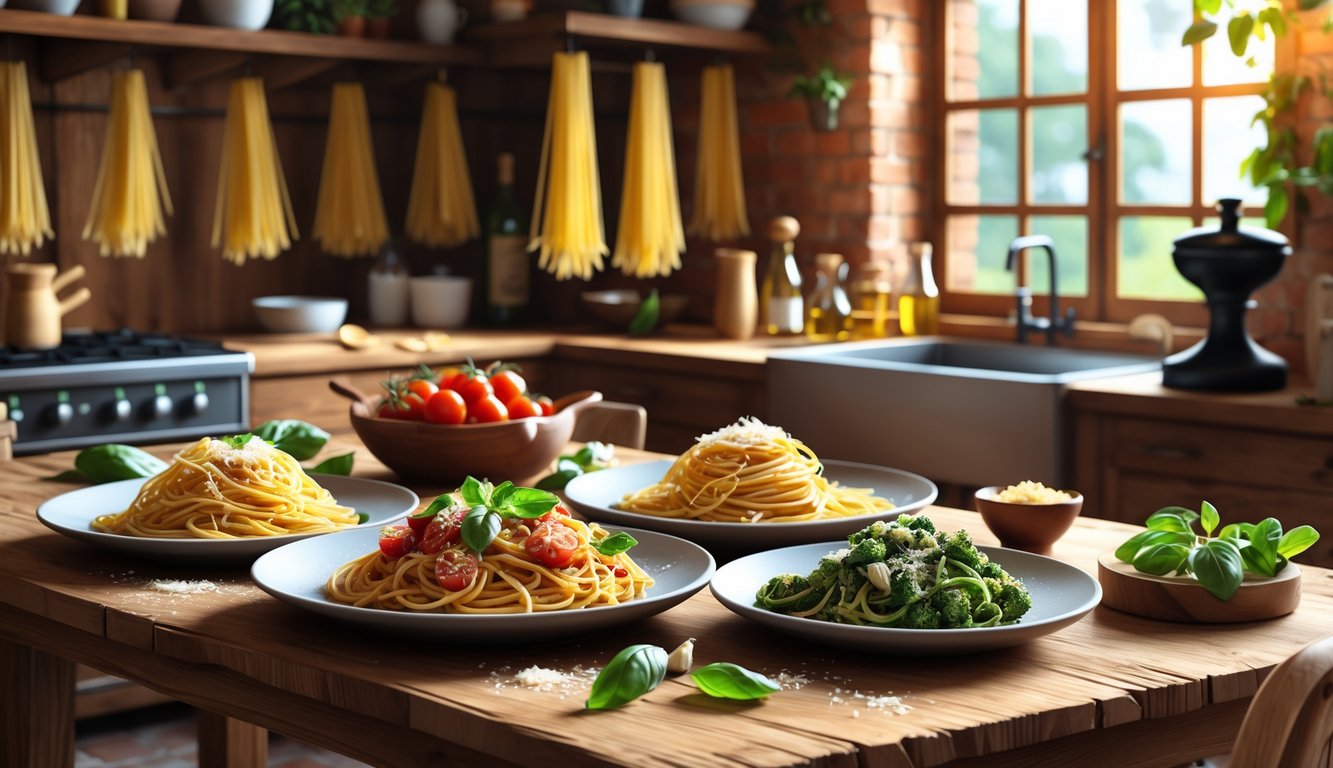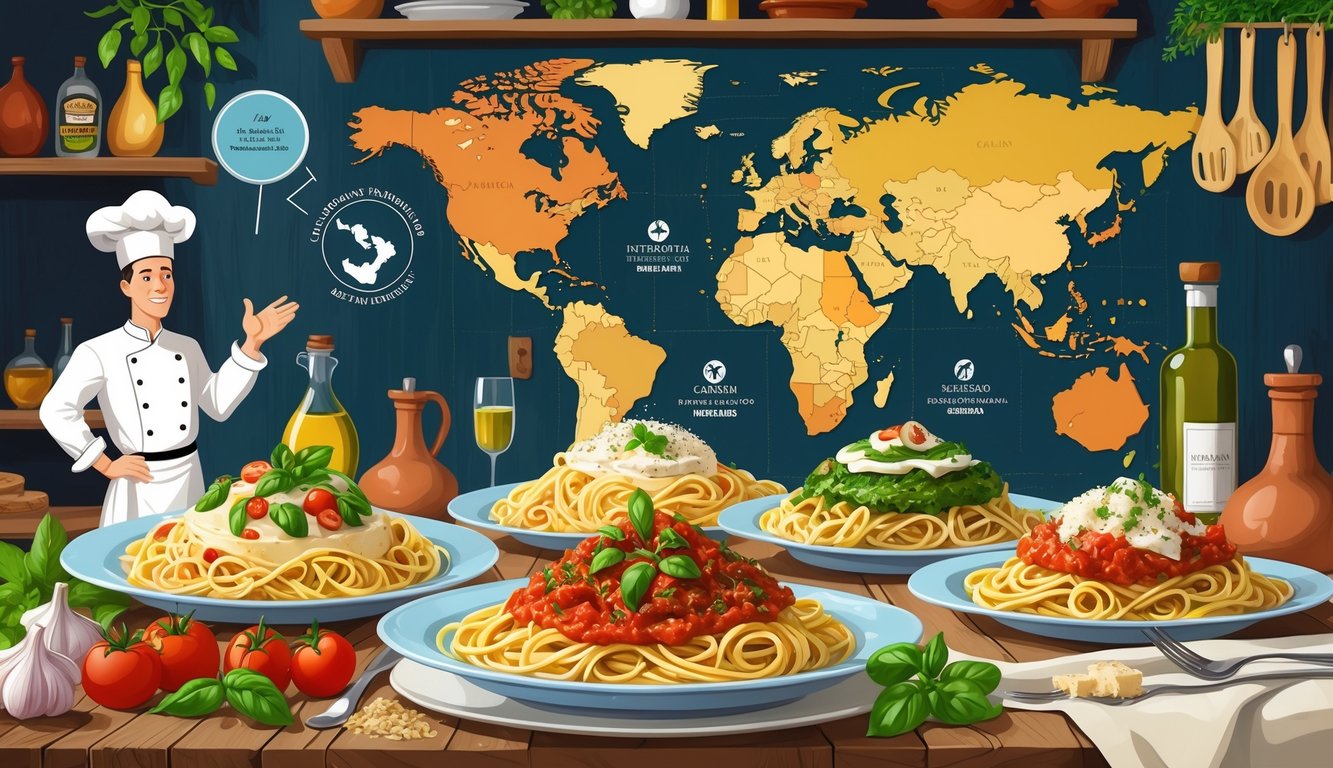
Why Fettuccine Alfredo Is Unfamiliar in Italy
I can’t remember the last time an actual Italian looked at “pasta Alfredo” without groaning. Never seen it at a real dinner table in Rome unless tourists are there. People act like Parmesan and cream are Italy’s biggest exports, but order this dish in Florence and locals just think you’re confused. Maybe you are. I mean, aren’t we all, sometimes?
Origins Versus American Adaptation
Look, I used to think fettuccine Alfredo was some ancient Italian ritual passed down by generations of grandmas, but nope—turns out, it’s a random Roman invention from 1908. Alfredo di Lelio whipped it up for his pregnant wife, not because of some sacred culinary code, but because cravings are wild. I mean, you’d expect a dish this famous to have roots deeper than a pothole in Trastevere, but it’s just butter, Parmigiano Reggiano, and pasta. No cream. Not even a drop. The stuff you get in American chain restaurants? That’s a totally different beast—cream, butter, cheese that tastes suspiciously like it belongs on nachos. I read this article that basically says American Alfredo is a reimagined export, and honestly, yeah, that tracks.
I keep hearing people ask why you can’t find “authentic” Alfredo everywhere in Italy. Newsflash: outside a couple of Rome’s tourist traps (two, seriously), you’re out of luck. My friend Giulia, who’s Roman and way too amused by American food tours, told me, “It’s like asking for deep dish in Naples.” She’s not wrong. Milan, Naples, Palermo—nobody’s craving a bowl of creamy noodles. When Italians spot “pasta Alfredo” on a menu abroad, it’s like seeing pineapple on pizza. Just confusion and a little bit of judgment.
Italian Preferences for Sauce
If I’m being honest, I’d be happy never seeing another white sauce for the rest of my life. Italians still swear by tomato and olive oil—simple, fresh, not drowning in dairy. The classics? Aglio e olio, amatriciana, carbonara—never a heavy cream blanket. My aunt (who, by the way, has more opinions than recipes) always tells me, “Light, balanced, and for the love of God, no cream where butter and cheese will do.”
Try sneaking Alfredo sauce into a small-town trattoria and watch the locals act like you’ve brought an alien to dinner. I saw a Eurispes survey once—most Italian sauces are tomato-based, maybe fish or veggies, not cream. In Venice, tortellini gets butter and sage, but it’s a whisper of butter compared to the American stuff.
Every time someone orders Alfredo here, I can hear the chef groaning from the kitchen. Italians want sauce to highlight the pasta, not smother it. Is that so much to ask?
Cheese in Italian Pasta
I feel silly even bringing this up, but cheese in Italy? It’s a sprinkle, a finishing touch. Parmigiano Reggiano, Grana Padano—grated on top after the pasta’s sauced. Cacio e pepe is the weird exception (cheese and pasta water, but still, no cream). American Alfredo? Cheese mixed right into a creamy, thick sauce. Totally different vibe.
I talked to a chef in Rome who said Americans sometimes ask for extra mozzarella in Alfredo pasta. Mozzarella? That’s not even the right cheese. No Italian would ever stir mozzarella into a white sauce. It’s not tradition, it’s not texture, it’s just… no. I’d bet even the cows here would protest.
Italians obsess over fresh ingredients—tomatoes from the garden, olive oil pressed last fall, cheese cut straight from the wheel. Mass-produced cream sauce? That’s what they avoid. Cheese is a finishing move, not the star of a heavy sauce. Drowning pasta in cheese is something you’ll only see where tourists outnumber locals.
Spaghetti and Meatballs: An American Comfort
I’m just going to say it: every time someone asks if Italians eat spaghetti and meatballs, I flinch. Polpette? Sure, they exist. But nobody’s tossing them on spaghetti here, and if you find a chef doing it, I’d question their entire resume. The myth that you’ll find them together on a real Italian menu—nope, not happening.
Polpette as a Separate Dish
The first time I saw “spaghetti and meatballs” advertised outside Italy, I honestly thought it was a prank. Italians love polpette (that’s meatballs, for the record), but they’re a secondo or a snack—never tangled in pasta. I watched a chef in Rome, nervously rubbing his hands, basically say, “Pasta is pasta, meatballs are meatballs. They don’t mix.”
A 2022 poll by Il Cucchiaio d’Argento? Less than 3% of Italians picked “spaghetti con polpette” as a favorite pasta. You’re more likely to find a working GPS in Naples. In Naples itself, polpette might be veal, beef, or even bread and cheese, but always on their own. Tuscany? Same deal—meatballs show up after the pasta, not with it.
Spaghetti is a solo act here. One chef told me, “Pair them abroad if you want, but not in my kitchen.” Fair enough.
How Italian Chefs Serve Meatballs
Watch an Italian chef make meatballs and you’ll see the obsession—moist, veal-heavy, almost fluffy, and tiny. Nothing like those baseball-sized monsters you get in diners. In Bologna, I saw meatballs the size of olives as antipasto, which, for some reason, came after a nine-course lunch. Time in Italy is weird.
What still drives me nuts is how sauces work. No drowning. Tomato sauce clings, doesn’t swamp, and meatballs keep their dignity. My friend Gianni swears by stale bread soaked in milk—skip the egg, he says. Polpette float in a rich sugo, maybe veal or pork-beef, sopped up with bread, but never dumped on pasta.
Even the nicest Italian grandmothers look horrified at the thought of bribing kids with spaghetti and meatballs. They’d serve you Nutella ravioli first (which, yes, exists, and I’ve eaten it twice—no regrets, but also, kind of regret).
Spaghetti With Meatballs Abroad
Outside Italy? Spaghetti and meatballs is comfort food royalty. Family tables, red-checkered tablecloths, “Sunday sauce”—it’s everywhere in the US. Not Italian, but who cares? Historians say it’s a mash-up from Italian immigrants in early 1900s New York—thanks, cheap beef and canned tomatoes.
I tried it in Boston once—giant meatballs, sweet marinara, not a Nonna in sight. Ask for it in Florence, and you’ll probably get handed an English menu or just a spritz and a skeptical look.
It’s nostalgia now. Lady and the Tramp, olive oil commercials, the works. Authentic? Nah. Comforting? Millions think so. If you want real “cucina italiana,” stick to cacio e pepe—unless you’re in the mood to play tourist.
Misunderstood Sauces and Pasta Combinations

Sometimes I can’t even finish the plate—watching the gap between what’s under fluorescent lights and anything you’d see in an Italian kitchen. Not nostalgia. Just confusion. How did anyone decide these combos made sense?
Creamy Sauces in Italian Cooking
Everyone in the US seems obsessed with fettuccine Alfredo. Walk into a Roman trattoria and ask for cream on your pasta, and you’ll get a look that says, “Are you lost?” Italian creamy sauces? They’re not what you think. Usually it’s just butter, Parmigiano Reggiano, maybe egg. Never that thick cream blanket.
Fettuccine Alfredo? Just butter and cheese in the real version. The point is, Italian sauces are about balance, not goo. Anna Del Conte, culinary historian, said, “Italian sauces are barely enough to dress the pasta.” No gravy blankets, no gluey mess. Fettucine and tagliatelle want light, clinging sauces. Surface area science, apparently—nerd out here. And chicken Alfredo? Never seen it in Rome, Milan, or even at a gas station.
The Truth About Marinara Sauce
American marinara is everywhere—red, sweet, garlicky, dumped on chicken, whatever. In Italy, “marinara” means something totally different: quick tomato, garlic, oregano—simple, fresh. The name and the taste get totally lost outside Naples.
Jarred sauce with corn syrup? No way. Italians laugh at the idea that pasta sauce should be deep red or simmer for hours. Tomatoes get pulped, warmed, served. A chef in Florence once told me, “If it takes more than fifteen minutes, you’ve ruined it.” Also, nobody puts it on chicken cutlets—that’s a tourist thing.
Pasta and Chicken Pairings
Chicken parmesan. Pasta with chicken. Somewhere, someone in the US decided they belong together, but I’ve never seen it in Italy—not at home, not at a real osteria. Chicken is a secondo, not a pasta topping. No deep reason, it just doesn’t work. Sequence matters here, not piling everything onto one plate.
A guy in Bologna once told me, “Pasta and chicken? Wait for the meat course.” Even in the most relaxed trattorie, nobody’s tossing grilled chicken into rigatoni. Try explaining this primo-secondo thing to someone, and someone else will mutter about Olive Garden. Every time.
Penne alla Vodka Abroad
Every menu outside Italy has penne alla vodka—huge portions, pink sauce, cream, canned tomatoes, vodka, sometimes chicken or shrimp (why?). The origin story is a mess, but honestly, I’ve never seen a real Italian home cook use vodka for anything but a late-night drink.
Yeah, there’s a Roman version, but it’s rare, niche, and nothing like the American-Italian one. Real Italian style? Just a splash of vodka to open up the tomato, not to make a boozy pasta. If your penne alla vodka is thicker than soup, just give up. There are better things to do with pasta and vodka—like, keep them far apart. Curious about why wide pastas get creamy sauces? There’s a breakdown here.



